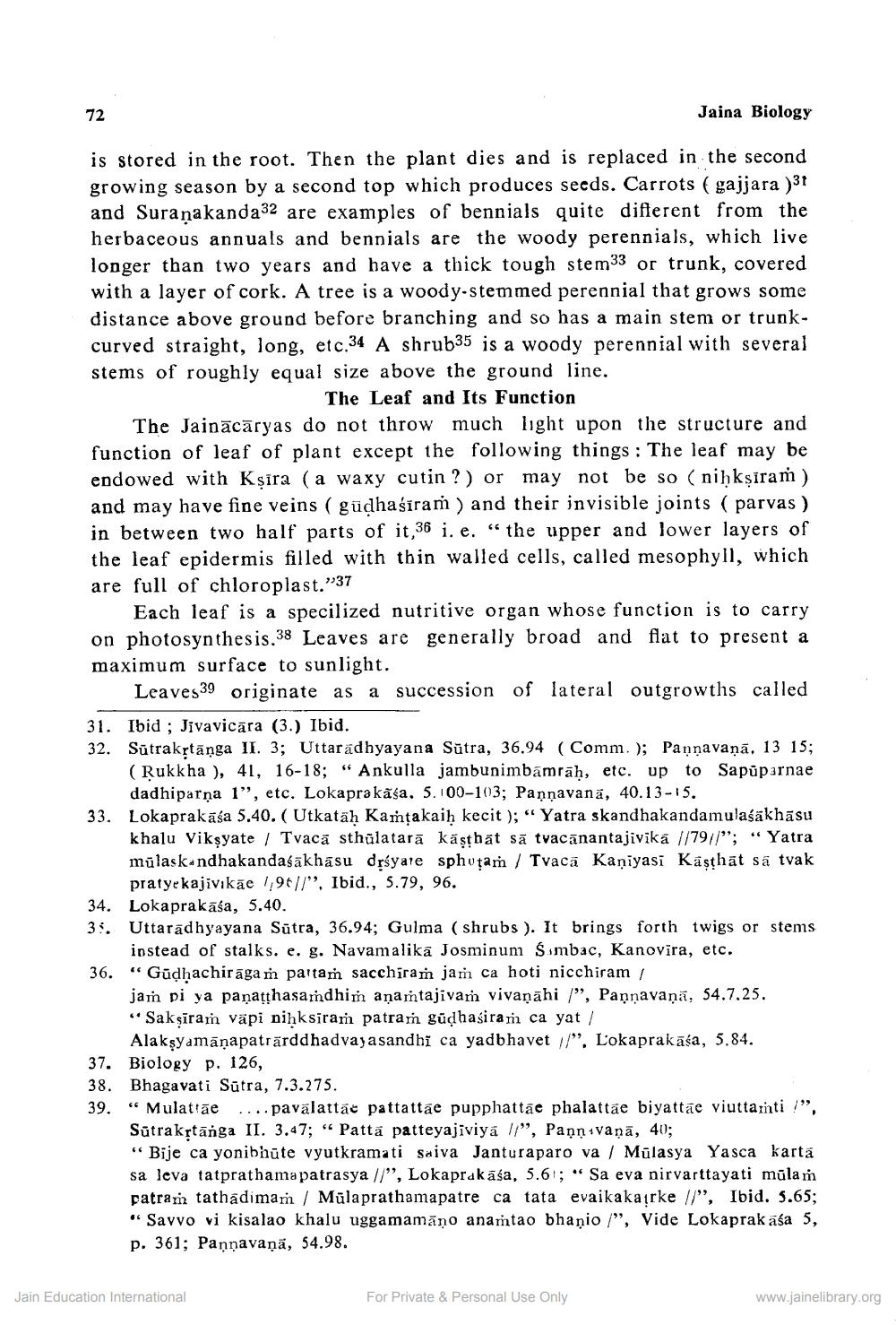________________
72
Jaina Biology
is stored in the root. Then the plant dies and is replaced in the second growing season by a second top which produces seeds. Carrots ( gajjara )31 and Suranakanda32 are examples of bennials quite different from the herbaceous annuals and bennials are the woody perennials, which live longer than two years and have a thick tough stem33 or trunk, covered with a layer of cork. A tree is a woody-stemmed perennial that grows some distance above ground before branching and so has a main stem or trunkcurved straight, long, etc.34 A shrub35 is a woody perennial with several stems of roughly equal size above the ground line.
The Leaf and Its Function The Jainācāryas do not throw much light upon the structure and function of leaf of plant except the following things : The leaf may be endowed with Kșira (a waxy cutin ?) or may not be so (nihkṣiram ) and may have fine veins ( güdhaģiram) and their invisible joints (parvas ) in between two half parts of it,36 i. e. “the upper and lower layers of the leaf epidermis filled with thin walled cells, called mesophyll, which are full of chloroplast."37
Each leaf is a specilized nutritive organ whose function is to carry on photosynthesis.38 Leaves are generally broad and flat to present a maximum surface to sunlight.
Leaves 39 originate as a succession of lateral outgrowths called 31. Ibid ; Jivavicāra (3.) Ibid. 32. Sūtrakrtānga II. 3; Uttaradhyayana Sūtra, 36.94 (Comm.); Pannavaņā, 13 15;
( Rukkha ), 41, 16-18; “ Ankulla jambunimbamrāh, etc. up to Sapuparnae
dadhiparņa 1", etc. Lokapra kāśa, 5.00-103; Pannavana, 40.13-15. 33. Lokaprakāśa 5.40. (Utkatah Kamtakaih kecit ); “Yatra skandhakandamulaśākhāsu
khalu Vikşyate / Tvacă sthūlatarā kāşthāt sā tvacānantajivika 1/791/”; “Yatra mūlaskandhakandasākhāsu dịśyare sphvtam / Tvaca Kaniyasi Kasthāt sā tvak
pratye kajivikāe 1,961/", Ibid., 5.79, 96. 34. Lokaprakāśa, 5.40. 3. Uttaradhyayana Sūtra, 36.94; Gulma (shrubs ). It brings forth twigs or stems
instead of stalks. e. g. Navam alika Josminum Simbac, Kanovira, etc. 36. “Gūdhachirāga m paltam sacchiram jam ca hoti nicchiram /
jam pi ya panatthasardhim anamtajivam vivaņāhi /", Pannavaņā, 54.7.25. “Saksīram väpi nihk siram patram gūdhasiram ca yat/ Alakşyamāṇapaträrddhadvayasandhi ca yadbhavet/". Lokaprakāsa, 5.84.
Biology p. 126, 38. Bhagavati Sūtra, 7.3.275. 39. “Mulattae.... pavälattāc pattattae pupphattae phalattae biyattae viuttarti !",
Sūtrakrtānga II. 3.47; “ Patta patteyajiviyá //", Pann vanā, 40; “Bije ca yonibhūte vyutkramati saiva Janturaparo va / Mülasya Yasca karta sa leva tatprathamapatrasya //", Lokaprakāśa, 5.61; "Sa eva nirvarttayati mulam patram tathadimam / Mülaprathamapatre ca tata evaikakaļrke //', Ibid. 5.65; “Savvo vi kisalao khalu uggamamāno anamtao bhaņio /", Vide Lokaprak āśa 5, p. 361; Pannavaņā, 54.98.
Jain Education International
For Private & Personal Use Only
www.jainelibrary.org




